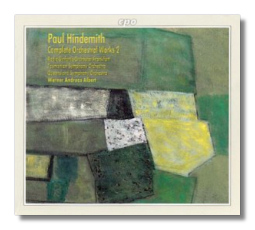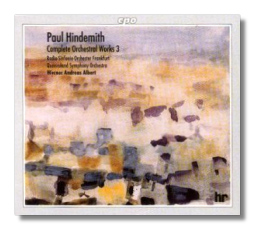
The Internet's Premier Classical Music Source
Related Links
- Hindemith Reviews
- Latest Reviews
- More Reviews
-
By Composer
-
Collections
DVD & Blu-ray
Books
Concert Reviews
Articles/Interviews
Software
Audio
Search Amazon
Recommended Links
Site News
 CD Review
CD Review
Paul Hindemith
Complete Orchestral Music

Volume 2
- Film Music: In Sturm und Eis (selection)*
- Kammermusik #1, 2 & 3 *
- 5 Pieces for String Orchestra, Op. 44/4
- Excerpts from Plöner Musiktag
- Suite Französischer Tänze
- Konzertmusik, Op. 49
- Cello Concerto, Op. 3 *
- Cello Concerto (1940) *
- The Four Temperaments
- Piano Concerto
- Der Dämon, Op. 28
- Hérodiade
Various Soloists
Radio-Symphony Orchestra Frankfurt/Werner Andreas Albert
* Tasmanian Symphony Orchestra/Werner Andreas Albert
** Queensland Symphony Orchestra/Werner Andreas Albert
CPO 999783-2 5CDs


Volume 3
- Clarinet Concerto
- Horn Concerto
- Concerto for Trumpet, Bassoon, and Strings
- Concerto for Flute, Oboe, Clarinet, Bassoon, Harp and Orchestra
- Violin Concerto
- Kammermusik #4, 5, 6 & 7
- Tuttifäntchen, Orchestral Suite
- Konzertmusik, Op. 48
- Der Schwanendreher
- Trauermusik
- Organ Concerto
Various Soloists
Queensland Symphony Orchestra/Werner Andreas Albert
CPO 999784-2 4CDs
Paul Hindemith was one of the most versatile and highly respected composers of the 20th century. He was original, too, forging a style that was instantly recognizable, rarely turning out a weak composition, and producing a large catalog of works. Yet, how often have you ever heard him mentioned as vying for top honors among composers of the 20th century? Over the years three names have consistently popped up here: Stravinsky, Prokofieff and Shostakovich. Sometimes Bartók is mentioned and maybe Benjamin Britten. But Hindemith is overlooked, not only because of some quirks in his musical persona – writing for odd combinations of instruments, for instance – but because his career was detoured in mid-stream when he fled Nazi Germany and came to the United States. Moreover, he was never really a careerist, like the most prominent three above, who knew how to advance their cause and make the necessary inroads to succeed.
Still, supporters of Hindemith must concede that he wrote the fewest standard repertory works of these leading figures. While he composed many masterpieces, his less colorful style – a style which does little to draw attention to itself – does not go over as well with the public. These two volumes of music attest to his immense talent, and while it may not rise to the level of Prokofieff's or Stravinsky's, it was a rare talent still.
I missed the first volume in this series, which contained many of the composer's better known works. These recordings offer music just as good and in performances of consistently high level. The second volume leads off with music from the film In Sturm und Eis, which features band-like scoring, a multi-colored musical fabric and some occasional brashness. Not great music, but interesting and worth an occasional hearing. Kammermusik #1, for small orchestra, follows. It begins with vigorous, colorful washes of sound that call to mind the opening of Respighi's Pines of Rome. This work brims with energy and features much attractive music, but is ultimately not great art.
The Five Pieces for String Orchestra, short though they are, are worthwhile and feature considerable depth in their often dark moods. Throughout this disc, this Tasmanian ensemble performs admirably, even if it's not a top flight group. The Plöner Musiktag excerpts and the Französischer Tänze music are colorful though less interesting items by Hindemith. The dance music is attractive, but divulges the less convincing lighter side of this composer.
The Kammermusik #2, for obligato piano and twelve instruments, is colorful and immediately appealing in its first movement – without sounding cheap or resorting to artificial devices – while the second movement is weird and darkly atmospheric. The final two are generally light and brilliantly scored. The Konzertmusik for piano, brass and harps, is another strong work from Hindemith, but its somewhat austere character will probably inhibit its popularity.
Sigfried Mauser performs these works with utter commitment, as he does the two on Disc 4, The Four Temperaments and the Piano Concerto. In the former pair he is ably abetted by the Radio-Symphony Orchestra Frankfurt, and in the latter by the Queensland Symphony Orchestra. The Four Temperaments is a colorful work, written for George Ballanchine's ballet company. The music sounds quite balletic and is perhaps a bit more approachable than the Piano Concerto, a fine work but a slightly complex one that will probably remain largely ignored.
The three works for Cello and Orchestra – the first and last concertos, and the Kammermusik #3, for obligato cello and ten solo instruments – get excellent readings from David Geringas, who has had a fine career, often performing unusual repertory, such as Prokofieff's little-played Concertino, as well as works by Schnittke, Gubaidulina, and other Russian avant-garde figures. Here, he renders the Richard Strauss-flavored student Cello Concerto with feeling and intelligence. The other two compositions on the disc are better, of course, and Geringas captures the essence of both quite convincingly. These are among the finest solo performances in either set.
The fifth disc contains ballet music from Hindemith's early years, Der Dämon, and from his American period, Hérodiade. The first is often brash, but is still appealing thematically. The latter is a more subtle piece, and was described by the composer as "an attempt to blend words, poetic ideas, lyrical expression and music…" The music is haunting and often dark, and comes across with a depth that can offer many rewards to the listener. Albert interprets both these pieces with an incisive grasp of their expressive soul, and his Frankfurt-based players render them with total commitment.
In the third volume, the first CD presents the 1947 Clarinet Concerto and three concertos from 1949 – for Horn; for Trumpet, Bassoon and Strings; and for Flute, Oboe, Clarinet, Bassoon, Harp and Orchestra. As most may already know, Hindemith could play many instruments with great proficiency, which gave him insight to the intricacies of writing virtuosic music for them. The Clarinet Concerto is quite attractive and ought to be more popular. Hindemith dedicated it to Benny Goodman, who premièred it with Ormandy and the Philadelphia Orchestra in 1951. The notes describe Goodman as a jazz clarinetist, but he was also a fine Classical artist, too.
The Horn Concerto is another worthwhile piece. Written for the virtuoso Horn player Dennis Brain, it is a muscular work that features the composer's usual fine writing for the instrument. The other wind concertos here are not well known but are of considerable interest and may appeal to a wider audience with greater exposure. The performances are excellent, with Ulrich Mehlhart, on clarinet, and Marie Luise Neunecker, on horn, delivering splendid accounts of their respective concertos.
Juilliard-trained Australian violinist Dene Olding turns in a thoroughly compelling readings of Hindemith's Violin Concerto and the Kammermusik #4 for Violin and large chamber orchestra. The latter piece, rather grotesque and humorous, will probably never become popular. Too bad, because it is a colorful, thoroughly enjoyable work that contains brilliant and atmospheric scoring.
The Kammermusik #5, which calls for a viola soloist, gets a fine reading from Brett Dean, himself a composer of some renown. He and Albert provide plenty of drive and energy to the first movement, and lots of dark atmosphere to the haunting second. Dean does well with the Hindemith Third Viola Concerto, Der Schwanendreher (Concerto after Old Folk Songs), a lyrical and quite lovely work. Kammermusik #6 and the Trauermusik also feature Dean, the former work on the viola d'amore. With that slightly different instrument he plays this one-movement piece, probably a more subtle effort than the preceding Kammermusik works.
Two organ works close out volume three – the Kammermusik #7, for organ and orchestra, and the Organ Concerto. Rosalinde Haas delivers fine accounts of both. And both are excellent works, the former perhaps a bit more colorful and atmospheric. Its second movement is eerie and dark, profound and ominous. The two surrounding panels are equally compelling for their rhythmic vigor and imaginative writing for the organ.
I've commented on almost all the works and performers in these two massive sets, and I hope I've missed nothing of importance. In sum, these two volumes – and probably the first in the series, as well – are worthwhile bargains for those interested in the music of this still-underrated composer, or even for those curious to sample some masterful and varied music from the 20th century.
Copyright © 2001, Robert Cummings



















